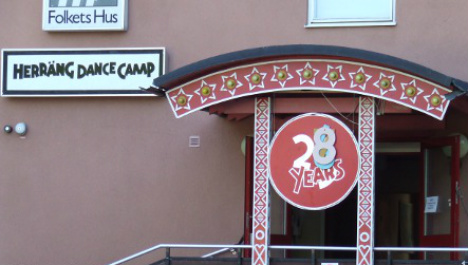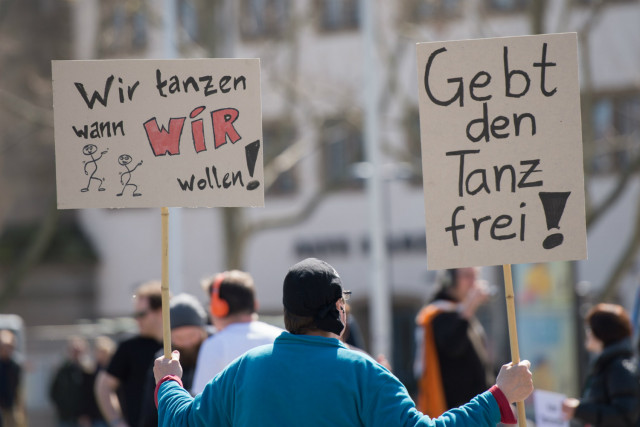”This camp has developed from being a regular little meeting of people with a selection of courses, to something of a semi-surrealistic theatre performance which means that a lot of people become children all over again. They leave their responsibilities at home,” Lennart Westerlund, one of the founder members and current co-owners of the camp, tells The Local.
Herräng has a proud history of industry and mining and the foundry still casts its shadow over the village, home to 443 people and located 100 kilometres north of the Sweden's capital close to where the Baltic Sea meets one of the country's largest inland waterways, the Dal river.
Each summer for the past 28 years the dance camp has transformed this sleepy Swedish outpost into a cosmopolitan hive of activity which in 2010 will involve 3,000-4,000 dancers from all over the world. This unlikely location was chosen largely by chance back in 1982 but has come to play a significant role in helping to make the camp what it is, Westerlund says.
”A big city has a lot of external temptations, it would be difficult to give the camp focus. Here there is only the dance camp, except for taking a walk or going swimming. The camp is incredibly concentrated and thus ensures a lot of contact between people, giving it a stronger intensity.”
The camp's growing popularity has meant the odd conflict with local residents but these are few and far between with the emphasis on a mutually beneficial understanding, Westerlund says.
”There are always perhaps a few who object but 98-99 percent enjoy the break. It shouldn't be forgotten that the camp contributes to the local society, not least financially…without the dance camp the local store would not exist, for example.”
Herräng's Folkets Hus is the hub of activites at the camp – a stately building set by an inlet and opposite the local school buildings which house a large part of the courses, teaching and accommodation. Participants sign up for a week at a time and follow a routine of classes, cultural activities and evening dances interrupted only by sleep and meals.
The camp day ends with an evening meeting, which on this first Wednesday of the camp summer is conducted in the form of a cabaret, with Sweden as a theme. Westerlund, clad in a dapper dinner jacket, introduces the participants who mix up the business of the day with song, dance and humour, all with an emphasis on audience interaction.
”We have a unique concept that you can't find anywhere else – everybody is encouraged to be a part of the camp, and not just a passive consumer,” he says adding, ”it was built on the principle that we said yes to everything, in most places it is no, if it doesn't fit in the business model or the organisation's favour.”
Westerlund recalls an occasion when the principle was put to the test.
”I remember that we had one man who insisted that he should have fresh milk every morning, it ended with him being given his own cow that he could milk himself.”
The evening meeting, like all other official events at the dance camp is conducted in English, a decision taken as a reflection of the camp's international participants with an emphasis on north, east and central Europe and the Americas.
The end of the meeting signifies the start of what could be described the real business of the Herräng Dance Camp – the social dance – a chance to test out all that knowledge acquired in the classroom during the day and to quite simply dance the night away in the company of disparate yet like-minded adherents to the lure of the Lindy.
Westerlund identifies the arrival of ”Lindy Hop icon” Frankie Manning at the camp in 1989 as the defining moment which transformed the camp and Lindy Hop, as far as the dance existed in Sweden, from being more of a competition dance to what it is today.
"With the arrival of Frankie Manning the dance changed in just a couple of years and the way the Swedes danced before almost disappeared. We realized that the whole dance was based on a social interaction and the social dance is now what it is about – that you can dance with anyone.”
Frankie Manning's last appearance at the camp was in 2007 and he died, aged 94, in 2009. The 2010 dance camp has been dedicated to the memory of a man whose influence and personality, Westerlund says, can not be underestimated.
”Frankie taught with a far higher quality than anything we had done before and his philosophy became completely dominant. He changed the scene by himself, more or less.”
Herräng Dance Camp works hard to retain its links to the swing era with open invites to the likes of Dawn Hampton, Sugar Sullivan and Chaz Young. Since Frankie Manning's death, Westerlund feels more than ever the collective responsibility to act as an ambassador for the Lindy Hop tradition.
”When Frankie Manning died it became even clearer for us to run this camp in the spirit which Frankie spread once upon a time and this includes a significant respect for the history around the dance.”
A cursory glance at the hundreds of dancers packing the four heaving dance floors of Folkets Hus on this sweltering Wednesday evening in early July, shows that while many display an approximation of the 20s/30s jazz era, more striking is the sheer variety of styles, ages and people mixing and changing partners in a happy mêlée.
The swing dances, and couple dances in general, enjoyed something of a rennaissance in the 1980s and Westerlund argues that this was a reaction to the more individual dance trends that began in the 1950s with the Twist and culminated with rave culture in the 1980s.
”I think many people feel a need to dance couple dances, I don't think that these people are moved to join a course where you stand alone,” Westerlund says, adding that ”the dance itself holds a high quality and has a huge social value.”
While Lennart Westerlund admits to not having owned a television for 25 years, he is aware of popular programmes such as Let's Dance (Sweden's version of Strictly Come Dancing) and thinks that they have a positive role in encouraging more people to take up dancing.
”The first thing people do is to they start with tango, salsa, lindy etc. as they exist in a social context. Even if I am not so interested in the type of dancing on offer, the programmes are an important gateway for many into the traditional social dances."
Whatever it was that first attracted the mixed bag of adherents on show in Herräng this and every summer to a dance and music genre now close to 80 years old, Westerlund is in no doubt of what the dance camp offers those taking the trouble to come.
"The camp is like a hurricane blowing through many people's lives today. It is completely different to what they are used to – I don't think many know what is happening in the world any longer. Herräng represents the world, and the world is represented here."
Check out The Local's Herräng Dance Camp gallery here.




 Please whitelist us to continue reading.
Please whitelist us to continue reading.
Member comments